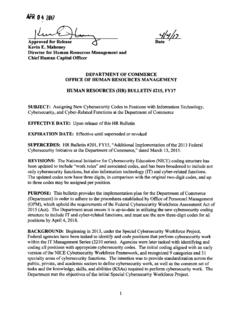Transcription of The Use of Negative Upcoming Events: Sequence Quantities ...
1 Published by Power System Engineering, 2013 The Use of Negative Sequence Quantities in Protective RelayingNegative Sequence Quantities originate from the theory of Symmetrical Components developed by Charles Fortescue in 1918. This theory states that an unsymmetrical set of phasors can be decomposed into one unsymmetrical but equal set of three phasors (zero Sequence ) and two symmetrical sets of phasors (positive and Negative Sequence ). Positive Sequence Quantities are found in all fault types as well as normal system operation. Negative Sequence Quantities are found in line-line (LL) and line-ground (LG) faults. Zero Sequence Quantities are found only in line to ground faults. Figure A illustrates an A-Ground fault. Note the presence of all Sequence networks and that all Sequence currents for A phase are aligned. Figure B illustrates a B-C phase fault. Notice that using superposition, A phase Quantities cancel out and B and C phase Quantities sum to their fault current magnitude.
2 Also note that zero Sequence currents are not present. Figure C represents a balanced 3 phase fault. This phasor diagram could also represent normal balance load conditions. Note that neither Negative nor zero Sequence Quantities are Events: Copyright 2013 Power System Engineering, Inc. (PSE)New Orleans, LAFebruary 18 - 21, 2013 PSE s Charles Plummer along with others will present Distribution Automation Case s Rick Schmidt along with others will present the following topics: Steps to Reducing Power Theft and FirstNet: Bring It On! PSE s Kevin Zamzow will present the following topics: Fiber Optics Illuminated through Utility Case Studies and Real Time Utility Performance Monitoring with an Operational s Chris Ivanov along with others will present Marginal Line Losses Reveal the True Value of Energy s Jeff Triplett will present Best Practices for Implementing Direct Transfer Trip , FLMarch 24 - 27, 2013 PSE s Jim Weikert along with others will present Automated Self-Healing Systems for Distribution s Rick Schmidt will present Utility Data Communications: Uncovering Emerging Technologies and Building a Strategic s Jeff Simdon along with others will present Bridging the Gap Between IT, Operations, and & OperationsTechnical ConferenceTraditionally, in overcurrent protection, zero Sequence Quantities are used to detect the ground faults illustrated in Figure A.
3 Zero Sequence Quantities offer a secure and reliable means for detecting ground faults. Positive Sequence currents are typically used for the three phase and LL faults illustrated in Figures B and C. Positive Sequence phase pickup current must be set above load current to prevent nuisance tripping. This decreases the sensitivity to LL faults. Because there are no zero Sequence currents in LL faults, zero Sequence ground fault protection will not work. In this situation, Negative Sequence currents found in LL faults are useful. Because no Negative Sequence Quantities exist in a balanced system, Negative Sequence pickups can be set below load current. The benefits are amplified when protecting a bus with multiple feeders. Continued on page 2 Downtime Fact: 93 percent of businesses that experienced datacenter downtime for more than 10 days went bankrupt in less than a : 2012 statistic from the National Archives and Records Administration, WashingtonPage 2 PSE / / The Utility EdgeSo why are Negative Sequence currents not regularly used in overcurrent protection?
4 There are three main reasons:1. When overcurrent protective devices were invented, symmetrical components were not understood on a widespread scale. 2. The technology to obtain Negative Sequence Quantities with electromechanical relays was complex and On systems with an ungrounded neutral, zero Sequence Quantities were optimal for detecting ground faults. With the advent of microprocessor based relays, the second reason listed above is no longer true. Similarly, because protection engineers better understand symmetrical components and because most systems in the US solidly ground their neutral, the first and third reasons are no longer valid. Some drawbacks, such as lack of familiarity with the application and coordination, could still deter their use, addition to the application already discussed, Negative Sequence Quantities are also used for: Motor and Generator Protection Protects against rotor damageDirectional relaying Provides reliable polarizing quantitiesLine Current Differential Adds sensitivity to high impedance LG faults and LL faultsPhase Selection Because Negative Sequence Quantities are in phase with zero Sequence Quantities in LG faults (Figure A) this information can be used to determine the faulted phase of a LG faultIn summary, with the invention and application of microprocessor based relays, Negative Sequence Quantities are another tool every protection engineer now has in his toolbox to design more secure and reliable systems.
5 Submitted by Doug F. Joens, PE Electrical Engineer from page 1 The Use of Negative Sequence Quantities in Protective RelayingSpectrum Acquisition for Communication SystemsPSE has a long history of helping our clients deploy communications systems for their utility applications. This communications support has intensified over the last five years as our clients focus on improved electrical grid analytics from locations across their territory. New utility communications are often wireless radio systems that require frequency spectrum to operate. Historically, when utilities added a new or upgraded their mobile radio system they licensed Part 90 frequency spectrum from the Federal Communications Commission (FCC) in the traditional method of going through spectrum coordinators. However, as entities upgraded their voice system to trunked radio, which requires exclusive use frequency channels, traditional licensable spectrum has become scarce. Additionally, as wireless advanced metering infrastructure (AMI) programs and feeder Distribution Automation (DA) have become cornerstones for many smart grid programs, the needs for spectrum have changed.
6 AMI wireless backhaul communications have unique propagation and spectrum concerns due to near-broadband bandwidth needs to remote locations that are non-line-of-sight. DA is often challenged meeting coverage and reliability expectations. Unlicensed 900 MHz spectrum sometimes has challenges reaching these sites and data radios utilizing lower 150 MHz and 450 MHz narrowband frequencies tend to not provide sufficient bandwidth for AMI takeout concentration points. These spectrum issues, and others, often require creative methods of acquiring licensed frequency to deploy wireless technologies in a modern utility environment. PSE has become very adept at analyzing our client s needs and recommending the best spectrum solutions available in their area. Some spectrum services we support: Running propagation studies in all spectrum bands to determine the best frequency for the application Engineering search analyses to find exclusive use spectrum to license Providing coordination engineering studies to the FCC or Canada (Industry Canada) Locating spectrum on the secondary spectrum market Negotiating with spectrum brokers to partition their license to sell or lease Facilitating the completion of the required FCC regulatory documentation Specifically, PSE provided FCC Auction 87 support to assist several utilities acquire exclusive use paging spectrum that was re-purposed for mobile voice radio systems in preparation of the FCC narrowbanding mandate.
7 A 34-site mobile voice system in the Midwest probably could not have been deployed without the acquisition of spectrum in this auction. PSE has a proven track record on finding eloquent licensed wireless communications solutions for our utility clients. Contact us to discuss your critical wireless infrastructure design and spectrum needs. Submitted by Charles Plummer Director of Communications Infrastructure / / The Utility Edge Page 3 What is the cost of electricity? What does it mean to save money on electricity? When evaluating the effectiveness of a demand reduction program, these are simple questions, but the answers are complex and vary depending on a customer perspective, the first measure of cost or savings is the amount due on their monthly utility bill. Residential customers can take this a step further by comparing the kilowatts used, cost per kilowatt-hour rate, and any fixed charges on their current bill to bills from previous periods.
8 Commercial and industrial customers can also compare the amount due to previous periods, and often, provided the information is available on their bill, assess energy and peak demand charges. But for both customer classes, the electric bill includes generation, transmission, and distribution costs that sum to the total cost of electricity. The cost of producing electricity tends to change as the load and the mix of generation resources utilized to meet the load change. Generally, the decision to operate a particular generator is based on whether or not it is the lowest cost generation to serve the load. If an electric utility is able to buy from the market at a lower price than the cost of generating its own power, it will generally purchase power from the market. The wholesale energy market in the Midwest Independent Transmission System Operator, Inc. (MISO) was transformed to a centrally dispatched Regional Transmission Organization (RTO) market, or Day 2 market, on April 1, 2005.
9 This system of purchasing and selling energy allows electric utilities to make efficient use of their generation units and to buy power when their load exceeds their generating capabilities or when power can be purchased for less than their own cost of generation. In these markets, essentially all generation is sold to MISO, and all load is purchased from MISO. The energy price established by the RTO is not complete and does not include transmission, distribution, or the fixed costs of generation resources, The generation component makes up approximately 45% of the typical electric bill. This includes an allocation for the fixed cost of each facility as well as the variable operating costs, particularly fuel and maintenance. Fixed charges for distribution and transmission facilities necessary to serve customer energy needs are also allocated back to the ratepayers, with distribution costs comprising about 45 percent of the total bill and transmission costs comprising the remaining 10 percent.
10 These transmission and distribution costs do not vary much from month to month, and are typically allocated to customers based on their peak demand during the billing period. Programs must be evaluated in terms of their anticipated impact on each cost component, but utilities are faced with many layers of complexity. The ideal demand reduction program will provide cost savings for the generators, utilities, and residential and commercial customers, thus providing a win for all parties by Tom Butz, PE Senior Planning Engineer PSE A QUESTIONWhat Are the Real Savings of Demand Reduction Programs?What s New at PSEWe continue to grow and are excited to add the following professionals to our engineering and technical staff. Johnathan Marquardt, Electrical Technician Prinsburg, MN Kevin McCutcheon, Power Delivery Design Consultant Marietta, OH Rick Seeling, Senior Consultant, Electric Distribution System Planning and Design Minneapolis, MN Dave Wieben, Engineering Technician Minneapolis, MNPSE to Teach Upcoming EUCI CoursesFebruary 25 - March 1 Toronto, ONPSE s Chris Ivanov and Steve Fenrick will teach the following courses: Electric Load Forecasting: Introduction and Best Practices Demand Response: The Economic and Technology Considerations from Pilot to Deployment Benchmarking the Performance of Electric and Gas Distribution UtilitiesVisit EUCI s website for more 4 PSE / / The Utility EdgeEMPOWER Critical Peak Pilot Year 2 PSE s benchmarking program for cooperatives has helped managers answer the following questions:1.










